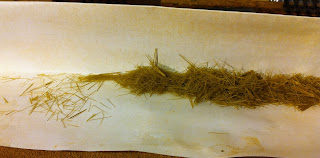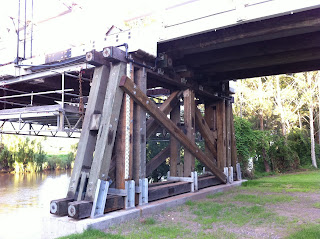



I thought I'd finish off the year with one last post, and again a title with a musical quote from "War is Over" by John Lennon. Sadly it was thirty years ago on the 8th of December that John Lennon was assassinated, and whilst as a nine year old in 1980 I remember my parents being in quite some shock over the news, I don't think the man meant much to me back then.
Now being older and somewhat of a Beatles fan and more aware of what John Lennon was all about, the lyrics he wrote mean so much more, and although written in a different time when the world was a different place, they still remain as appropriate and meaningful as ever.
But hey, this is a train blog, who wants to read about long gone musicians?
Well I thought I'd make this last post for 2010 about the things outside of the hobby that sometimes take up that oh so valuable modelling time.
The first picture is where I figured I spent about 630 odd hours of my time this year, travelling between my home in Woy Woy on the New South Wales Central Coast to Central Railway Station on the lovely old Inter Urban V-Sets. These electric passenger sets were introduced in the 1970's, but they are far and above the most comfortable ride on the N.S.W. railways in my humble opinion. Air conditioned, sound proofed, and featuring lovely comfortable two either side seats these are a relatively relaxing way to travel.
The 5am morning trip from Woy Woy usually sees me back to sleep by Hawkesbury River station ten minutes away, and waking up somewhere between Redfern (one stop from Central) or as it pulls into Central if I'm lucky. The afternoon trip trip gives me a great period of time to do some reading and then depending on how brain straining the day has been often another sleep on the way home. Overall it's a cost effective, safe and stress free way to travel and I still, after just over five years of living up here and doing this trip, still love crossing the awesome Hawkesbury River Bridge.
The second pic is of of dogs. My wife and I always talked about getting a house and having a dog, and after finally getting our place just under a couple of years ago, a dog has turned into four dogs! Paws on the left was our first, followed by Gizmo (2nd from right), and then a little later Coco (2nd from left) and Bruce (far right) came along.
All of them are rescue dogs that we got from animal shelters or from people who save dogs from the pound and try to find a home for them. Coco and Bruce were saved from a breeder who'd kept them in small cages all their lives, and so they really didn't know how to interact with people. The lady who saved them was convinced that they would probably not recover mentally from this treatment and it would be better for them to be put to sleep. Well, to see their little faces light up when my daughter is around, and the way they follow her around like she's the only thing in the universe is a wonderful sight, and bit by bit they have become very happy little animals.
As well as the four dogs there are four Cockatiels, two fish tanks, a Pink and Grey Galah and six chooks that produce the loveliest fresh eggs each day! Once again they all take up a bit of time, but it's well worth it.
The third pic is another hobby that keeps time and finances stretched! This Mazda RX-4 was bought brand new in 1974 by my Grandfather, and was part of what got me into cars and these wonderful Rotary Powered Mazda's in my mid to late teenage years. Truth be known the car phase is what caused all of my trains to be packed away for twenty or so years!
I bought this car off my Grandfather about eleven years ago, and it's been sitting in his garage until earlier this year when I brought it home and have begun getting it going again. The engine is currently out of it awaiting stripping and then I'll decide whether to put that basically standard engine back in or build something a bit trickier for it. Once again there is some time and money needing to be spent but the car is pretty special to me so it's a labour of love. My Grandfather who turned ninety in September is looking forward to going for a cruise in it again as well.
The last pics is of the aforemention Hawkesbury River Bridge, which takes the Main Northern Railway line across the Hawkesbury River. This pic was taken one Saturday when my wife and I took a long and leisurely cruise on the Lady Kendall that starts at Gosford around 10:30am, and takes in a cruise around Brisbane Waters, past Woy Woy, down past Ettalong and Umina, across past Lion Island and then up the Hawkesbury River, then doubles back and heads up through Pittwater before heading back past Palm Beach and across between the heads, through Brisbane Waters and back to Gosford, all of which takes about six and a half hours with morning tea, lunch and afternoon tea included.
The Lady Kendall is a traditional timber cruiser which is the last of the mini liners that was purpose built for Reg Ansett's Ansett Airlines for their Hayman Island operation. The owner and Captain of the Lady Kendall tells a rather amusing story about the fact that they no longer build timber cruisers anymore due to costs, and that he likes timber boats, because timber floats and he can't swim. He then says that people ask "how can he be a caption of a boat and not be able to swim", to which he retorts "have you ever seen a pilot who can fly!"
The point of mentioning the river cruise is to point out that amongst our travel too and from work and work in between, looking after our daughter and all the animals, general jobs around the house, domestic duties and even our hobbies, it's important to get away sometimes and just relax with your partner. Six and a half hours of cruising around the waterways with no distractions is a real nice way of doing that.
So getting back to the John Lennon song and the other lyrics "So This Is Christmas, And What Have You Done?", it's easy to look back and wonder why we haven't made as much progress with our modelling as we would have hoped, but when you look at the big picture and all of the other things that take time to do, it's a wonder we get as much done as we do sometimes!
So for now at 9:45pm on New Years Eve, I'd like to wish everyone a very Happy New Year, I hope that 2011 is full of health, happiness and well being, and hope that we can all fit in just a little more modelling time than we did in 2010!


























